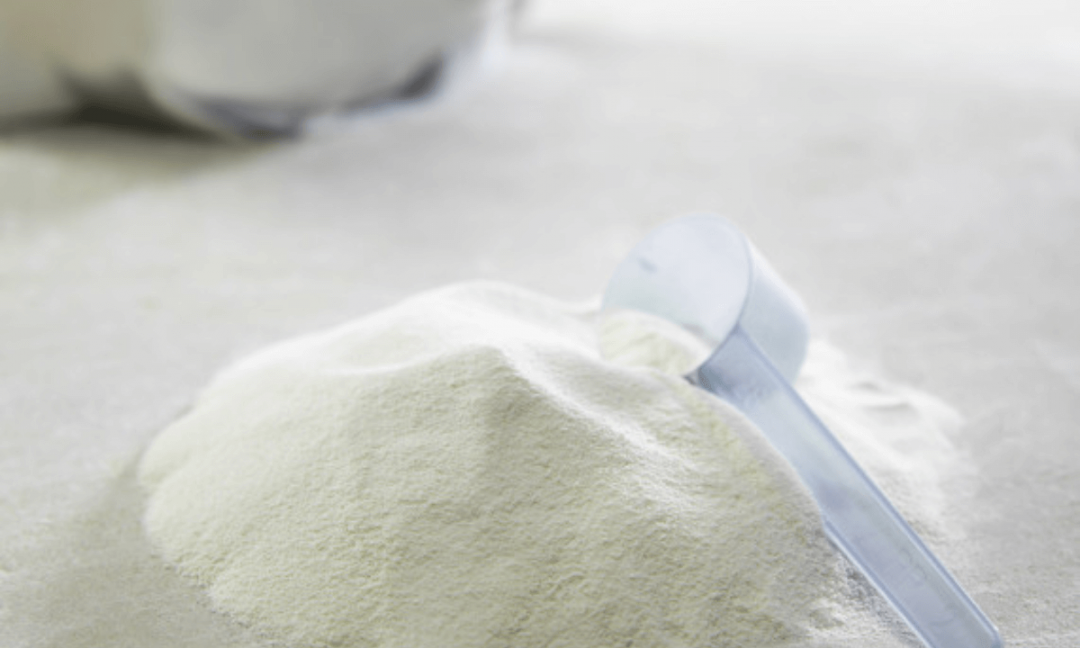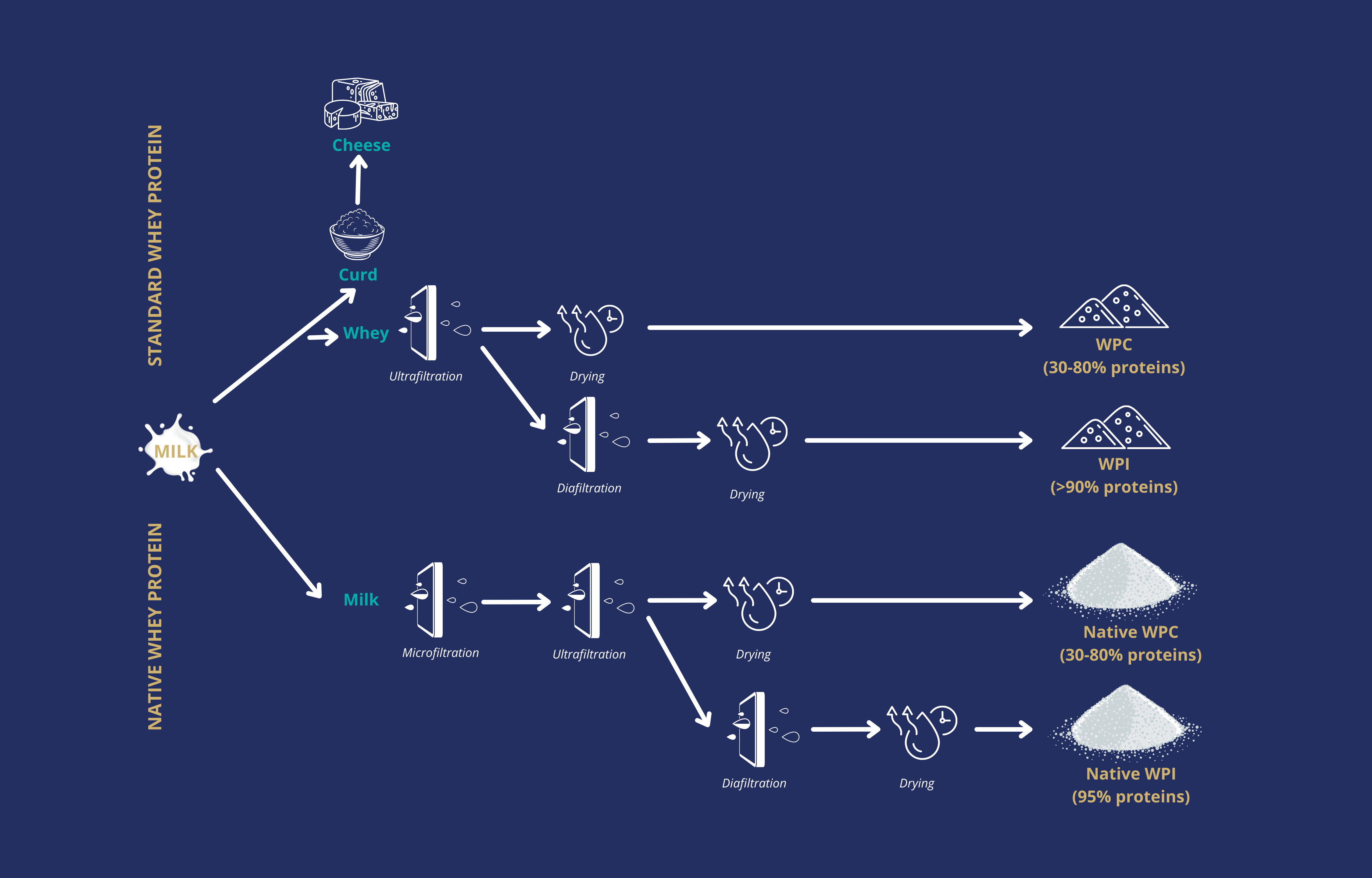
Concentrate VS isolate: Which whey protein depending on use?
Milk is a very complete, nutrient-dense food. It is mainly made up of water, but also contains proteins, carbohydrates – such as lactose – fats, vitamins, and minerals.
There are two types of milk protein : caseins, which are present in colloidal form and make up the majority (about 80%), and whey proteins, which are in soluble form and make up the minority (about 20%). The latter are valuable ingredients for the food industry and are used in many protein products.
Whey proteins are divided into concentrate and isolate, which are obtained from similar production processes but have different characteristics.
How are whey protein concentrates and isolates obtained ?
Whey proteins are obtained from whey, which is itself obtained during the cheese-making process. During this process, the milk coagulates due to the action of the rennet. After coagulating and while draining, the whey is separated from the curd.
Once the whey has been obtained, the whey proteins are concentrated by membrane ultrafiltration to remove part of the non-protein components. They are then dried to obtain a powder with a variable protein content.

The whey protein concentrate contains between 30% and 80% of protein in dry matter.
A second diafiltration step produces whey protein isolate. This step removes most of the other components, after washing several times. Most whey protein isolates on the market contain at least 90% protein in dry matter. As there are no regulations, this rate may vary from one product to another, and it is therefore possible to find isolates with 85% of protein.
There is also another way to extract whey proteins. LACTALIS Ingredients was a pioneer in identifying and perfecting this technique which allows for the gentle extraction of proteins by cold filtering the milk. This technology preserves the native properties and the nutritional value of the proteins. This natural process is used to obtain LACTALIS Ingredients’ Pronativ® and Prolacta® range of native whey proteins.
Concentrates and isolates – different uses
Concentrates and isolates have an exceptional nutritional value and important functional properties : low percentage of fat, neutral taste, and sometimes very high protein content depending on the type of product. They can therefore be found in a wide range of products : their ability to dissolve at various pH levels makes them ideal for sports drinks, while their ability to retain water makes them suitable for functional applications.
Infant nutrition
First of all, these whey proteins are valuable ingredients for formulating infant powders, in order to obtain a nutritional composition as close as possible to that of breast milk and cover the nutritional needs of children.
To ensure an adequate supply of essential amino acids, whey protein concentrates are commonly used in infant nutrition, especially concentrates with 35% or 80% protein in dry matter.
Whey protein concentrates are commonly used in infant nutrition, especially concentrates with 35% or 80% protein in dry matter
Native whey proteins are also particularly suited to this use. Directly extracted from milk through a physical membrane process, these proteins are more intact and retain their full nutritional and functional qualities.
The Prolacta® range by Lactalis INGREDIENTS is therefore intended for use in infant formulas. It is rich in alpha-lactalbumin, which is the main protein in breast milk. Its optimal amino acid composition also means it reduces the protein content of infant formulas, particularly thanks to its high tryptophan content.
Sports nutrition
The sports nutrition market is very dynamic and constantly growing, as is consumer interest in protein products. Whey protein isolate is a valuable ingredient in sports nutrition products due to its high protein content and easily digestible properties. Its lactose content is very low, even non-existent, making it ideal for people who are lactose intolerant.
Whey protein isolate is a valuable ingredient in sports nutrition products due to its high protein content and easily digestible properties
At LACTALIS Ingredients, a wide range of protein ingredients is used for sports nutrition and for making protein bars, powders, and drinks.
The Laktein WPC80/WPI range includes whey concentrates and isolates used to create protein products for athletes and active individuals.
LACTALIS Ingredients has also developed Pronativ® – Native WheyProtein, directly extracted by cold filtering. This natural process gives it higher nutritional value and characteristics than traditional whey proteins. Rich in essential amino acids, Pronativ® has a high level of leucine, essential for muscle synthesis and recovery. Available in different references, including an isolate with 95% protein on dry extract, this range is ideally suited to the needs of the sports nutrition market.
Concentrates and isolates are also available in an instant formula to provide consumers with powders that are ready to be reconstituted in water.
Functional application
Whey proteins concentrates are also used for their functional properties, in dairy products, for example. Their foaming qualities make it possible to improve the texture, creaminess, and organoleptic properties of the finished product.
Pronativ® and Laktein WPC80 in particular are two highly functional proteins that can replace eggs or be used in yogurts, particularly useful for formulating ‘clean label’ products.
Whey concentrates and isolates provide exceptional nutritional and functional properties. Their high protein content, low fat content, easy digestibility and solubility at various pH levels make them ideal for formulating many food products. By drawing on their specific characteristics, they can be used in a targeted manner depending on the desired effects and the target population.















